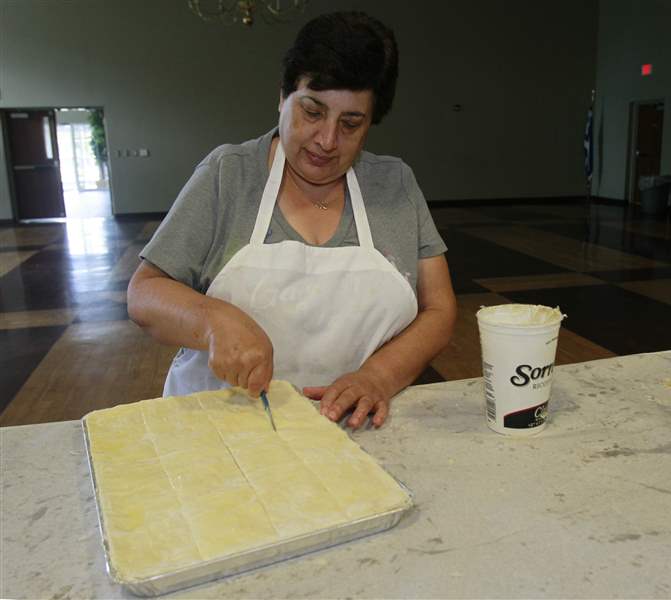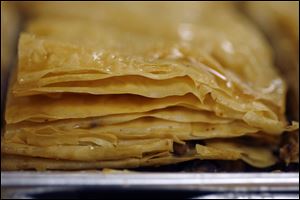
Like bees to honey, baklava draws crowds
What is it about baklava that makes it so irresistible?
9/3/2013
Olympia Ntakos, of Sylvania Township, one of the chairs, cuts the baklava and performs quality control.
The Blade/Jetta Fraser
Buy This Image

Olympia Ntakos, of Sylvania Township, one of the chairs, cuts the baklava and performs quality control.
What is it about baklava that makes it so irresistible?
Is it the honey? The walnuts? The layers and layers of phyllo dough? Layers and layers and layers of it?
It must be the entirety of the thing, the whole experience of eating it: the way the sweetness of the honey and the syrup blends with the ground walnuts, the way they all mix with the cinnamon and spices, and the way it is incorporated into the delectable crunch of the phyllo.
Layers and layers and layers of it.
The Greek-American Festival, which runs Friday through Sunday at Holy Trinity Greek Orthodox Cathedral, is now in its 43rd year. And for each of those 43 years, the star of the show has been baklava, the ubiquitous Greek dessert.
“Baklava is the traditional Greek pastry,” said Barb Atherine, president of the local chapter of the Greek Orthodox Ladies Philopotchos Society, which is like a ladies’ auxiliary. “If you have a baptism, if you have a wedding, there is always going to be baklava.”
And it is especially abundant at Greek festivals. At the local event, and indeed at festivals around the country, baklava is always the best seller.
Earlier this summer, a couple of dozen women and a handful of men got together to make this year’s batch. It was a two-day effort, requiring a tremendous amount of work. When all was said and done, they had made 5,760 pieces of baklava.
Each piece was made with between 40 and 48 pieces of phyllo dough (layers and layers!), a mixture of sugared walnuts, cinnamon, and cloves, and a syrup made from sugar, water, and honey. And butter — more butter than you probably need to know. Even though the pastries were made 48 at a time in sheet pans, it still represented an enormous amount of effort.
Every other sheet of the phyllo, at least, was coated with melted butter applied with a paintbrush (“go to a hardware store and buy an expensive paintbrush,” Ms. Atherine said). After 10 sheets of it were laid in the bottom of a pan, the sprinkled a few handfuls of the sugared walnut mixture on top. Then came another couple of sheets of phyllo, more butter, and more nuts. Layers were added onto layers until the top, which consisted of 15 sheets of phyllo dough. Every other sheet of phyllo was buttered until the top few, which were buttered individually.
“Everybody says, ‘Oh my God, it’s so sweet.’ And yet everybody eats it anyway, “ said Barb Hartford, who was busy making them.

Flaky baklava. Volunteers make \baklava at Holy Trinity Greek Orthodox Cathedral in Toledo.
Though it may seem like it at times, the Greek-American Festival is not just about the baklava. Traditional Greek dancing will be performed by four groups of dancers in different age groups from teens and adults all the way down to children from 3-6 years old. Community members will make presentations on Greek language and culture, and tours will be given of the cathedral.
But for most of the visitors, the festival is a chance to learn about Greek culture primarily through food. To that end, cooking demonstrations will be Friday at 7 p.m. with Jim Mitsopoulos showing how to make pastichio; Saturday at 6 p.m. with Kevin Haddad demonstrating how to make stuffed eggplant; and Sunday with Greg Cook showing how to make dolmathes (stuffed grape leaves) at 2:30 p.m. and George Kamilaris demonstrating the art of working with phyllo and various stuffings at 4:30 p.m.
And of course there will be mountains of food — layers and layers of it — everywhere, including such favorites as gyros, souvlaki, shish kabob, pastichio, moussaka, lamb shanks, chicken marinated with oregano, and Greek-style green beans.
This year, a new addition to the menu will be saganaki, the dish of flaming cheese with lots of lemon. It is almost a requirement to shout “Opa!” when one is being served.
Once the entrees have been eaten, there is always room for dessert. At least 10 different pastries will be offered, all of them homemade, from galaktoboureko (a custard pie) to loukomades (little Greek doughnuts) to karithopita (a walnut cake). But most folks will just head straight for the sweetness, the nuts, and the crunch of the baklava.
The festival will be held at the church, 740 N. Superior St. Friday from 11 a.m. to midnight, Saturday from noon to midnight, and next Sunday, Sept. 8, from noon to 7 p.m. Admission is free from 11 a.m.-3 p.m. Friday, $5 for the rest of Friday and Saturday, and $2 on Sunday. For more information call the cathedral office at 419-243-9189.
RECIPE
Baklava
- 2 pounds walnuts, finely chopped
- 1 tablespoon cinnamon
- 1/8 teaspoon cloves
- 6 cups sugar plus
- 1/3 cup sugar, divided
- 4 cups water
- 1 cinnamon stick
- 2-3 whole cloves Rind from
- 1 lemon ½ cup honey
- 1 pound unsalted butter
- 2 pounds phyllo dough, good quality
If you want to try making your own baklava, Olympia Ntakoscq provided this recipe:
Preheat oven to 350°.
In a bowl, mix together walnuts, cinnamon, cloves, and 1/3 cup sugar. Set aside.
In a saucepan, bring to a simmer the water, the remaining 6 cups of sugar, the cinnamon stick, the whole cloves, and the lemon rind. Simmer, stirring frequently, until the sugar is almost all dissolved. Add the honey and continue simmering and stirring until the sugar is dissolved. Remove the cinnamon stick, whole cloves, and lemon rind. Set aside to cool.
Use a small piece of butter to grease a baking pan. Melt the rest of the butter.
Place two sheets of phyllo dough in the baking pan and, using a good-quality paintbrush or pastry brush, spread melted butter all over them. Repeat 4 times, until you have 10 sheets of phyllo, with every other sheet buttered. Evenly sprinkle a handful of the nuts mixture on top. Cover that with two sheets of phyllo dough, and brush butter acros the top. Repeat the layers of nuts and phyllo, buttering every other sheet of phyllo, until you have 15 sheets of phyllo left. Lay these on top, spreading butter over every other sheet until there are three sheets left. Spread butter on each of these sheets.
Use a sharp paring knife to cut four rows in one direction and six rows in the other. Then cut each resulting square across diagonally, so each piece of baklava is a triangle.
Bake for 1¼ hours. Remove from oven and while still hot, evenly pour the syrup over the top, allowing it to soak in.
Yield: 48 servings; Source: Olympia Ntakos